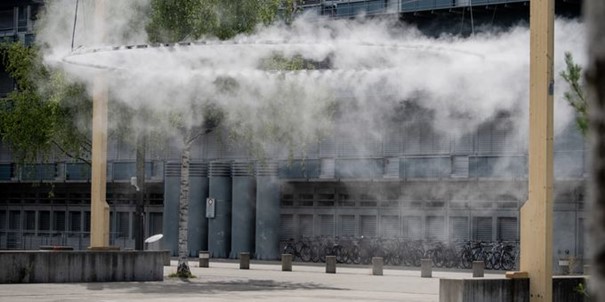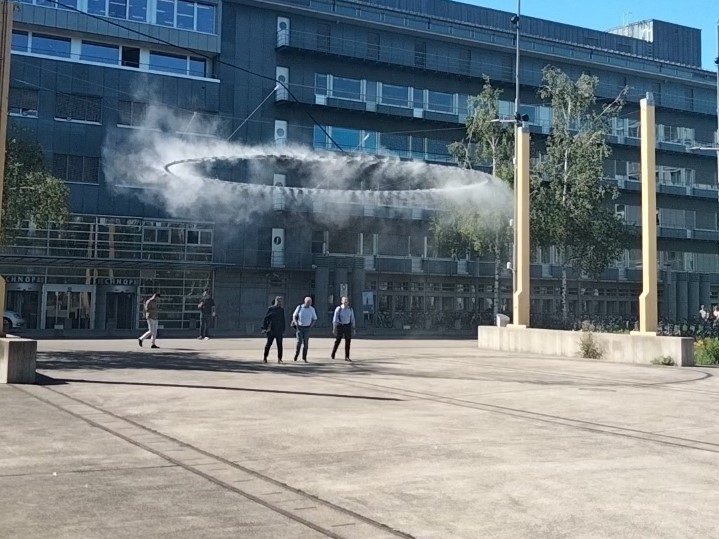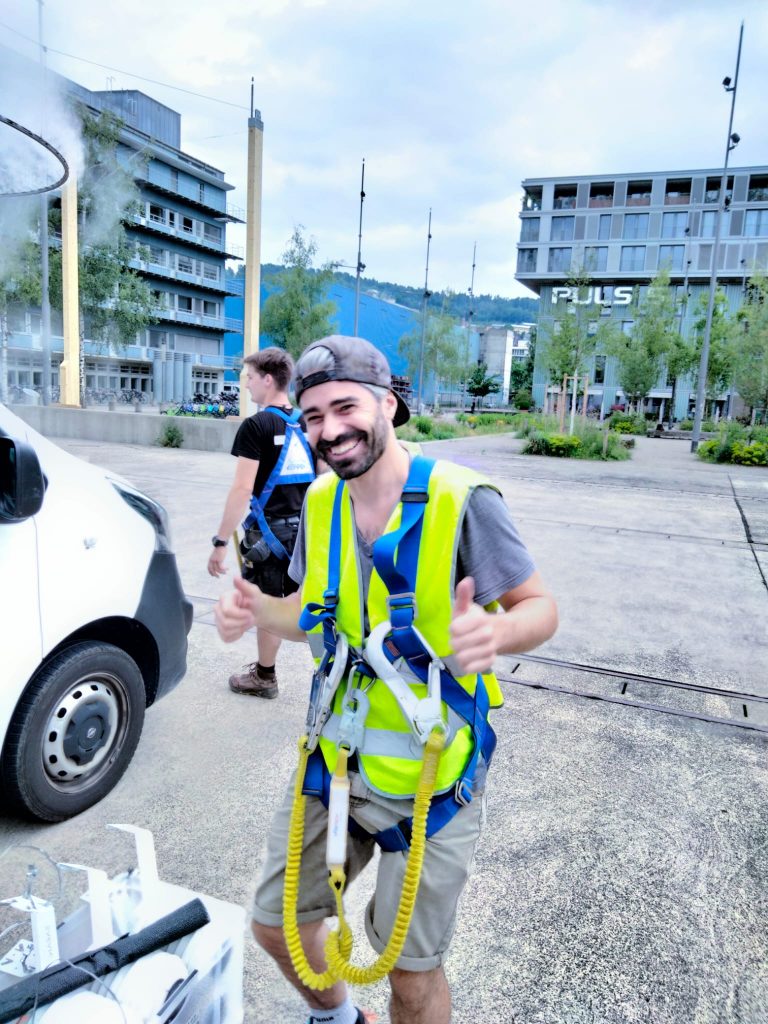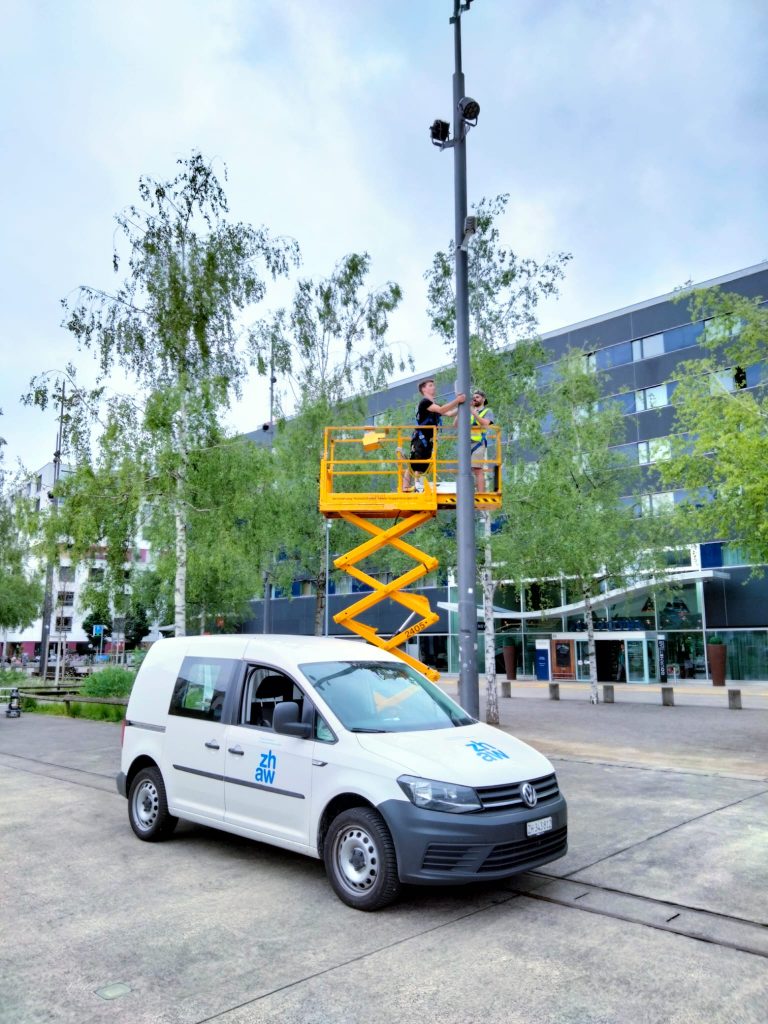Navigation menu
- Education
- Emissions & Air Quality
- Infrastructure & Services
- Meteorology & Climate
- News
- Physical Chemistry
- Projects

Passersby strolling across Turbinenplatz in Zurich these days, are treated with an unusual sight: A construction made of wood, strings and a metallic ring , hovering a few meters above ground and spraying a fine mist into the air, creating a cloud-like image. It is an installation by the city of Zurich, inteded to bring some cooling during hot days over the next three summers. This pilot project called “Alto Zürrus” serves the purpose of testing the installation for its cooling potential, as well as its appeal to the public.
Having quite a bit of history with urban temperature measurements and heat mitigation approaches, we were invited to support the city of Zurich in evaluating the clouds’ effect by providing scientific monitoring, continuously measuring local temperature and air quality during the ongoing season.
What’s the purpose?
While the cloud might appear like a pleasant addition to the public square, the reason behind it is a serious one: temperatures are on the rise. Driven by global warming, the number and duration of heat waves is increasing, with this past record-breaking June being the newest and, most probably, not the last example. During such heat waves, temperatures climb well over 30°C during the days and don’t go below 20°C in the nights, which is not just unpleasant, but can also pose health risk and even lead to increased mortality. Excessive heat, and thus the hazard it poses, are most pronounced in urban areas, which mostly consist of concrete buildings and sealed surfaces, which is why urban heat mitigation has gained increasing attention over the past years, also in the city of Zurich. While many studies commonly agree that unsealing surfaces, planting more trees and establishing green areas is the best strategy to follow on the long run, the cooling potential usually takes some time to develop its full potential. Reasons for that are a) repurposing surfaces might take a while, and b) trees don’t grow very fast. Consequentially, additional measures are needed to provide immediate relief. A spray mist cloud could be one of them.

How does it work?
The concept behind the cloud is basic thermodynamics: water evaporates and extracts heat from its environment, which has a cooling effect on the surrounding air. The tiny droplets generated by special nozzles enhance this effect, due to the increased surface area of the water and the resulting rapid evaporation. As the ring is installed a few meters above ground, most of the water has evaporated before it reaches passersby, while the air, which is now cooler and thus denser than the surrounding air, will sink towards the ground. Thus, in principle, you can walk by and enjoy a refreshing breeze, without your clothes (or mobile device) getting wet.
Why does it require monitoring?
If you pay the cloud a visit, you will notice that the cooling effect is well noticeable when you’re standing in singular places. If you move away (or the wind turns), you will quickly feel hot again. This does not necessarily mean that there is no cooling effect at all, but it implies that its intensity and reach depend on environmental factors, which is consistent with previous studies on other spray mist installations (e.g. Ulpiani (2019)). Environmental factors, which might affect the cooling effect of the cloud are (among others): ambient air temperature, relative humidity, wind speed and direction, ground temperature and solar irradiation. As a result, assessing the actual change in local temperature induced by the cloud is much more complex than simple thermodynamics. Consistent monitoring over the ongoing season will provide us with enough data to gain some insight on the average effect of the installation, it’s weather dependence and its reach. For this, we have mounted 13 sensors all over Turbinenplatz, which are continuously recording temperature, humidity, and other meteorological variables. In addition, we and our colleagues from the Institute of Chemistry and Biotechnology will also monitor the air quality around the cloud.


So, if you happen to be around the corner on a hot day, stop by Turbinenplatz, enjoy the refreshing breeze and marvel at our sensors. Stay tuned on this blog for some results later this year.
